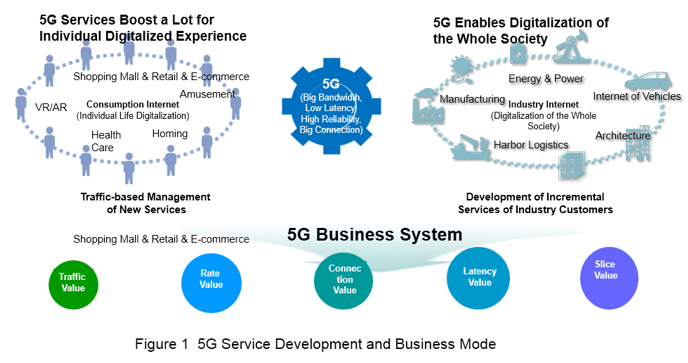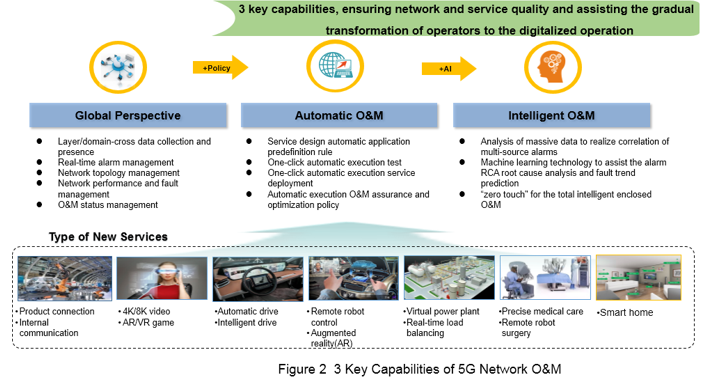2019 is recognized as the first year of 5G era. On April 5th, SK Telecom, KT and LG U+ from South Korea officially launched commercial services of 5G networkfor general consumers. Immediately thereafter, on April 16th, the Federal Communications Commission (FCC) announced that it will hold its 3rd millimeter-wave spectrum auction plan and promised to invest more than $20 billion to deploy 5G in rural areas. On April 23rd, China Unicom announced the provisioning of 5G test network in 40 cities at the Shanghai Partner Conference. Although the 5G network commercial wave has gradually grown up in the globe, it is still necessary to further improve the commercial capabilities of 5G network from the aspects of industrial technology maturity, service development and business model, and efficient network operation and maintenance.
I. Technology maturity of 5G network industry
On June 13th, 2018, the 3GPP Plenary (TSG#80) approved the freezing of the 5G independent networking (SA) function, marking official release of the truly complete international 5G standard. Different from the 4G standard, the 5G standard presents the characteristics of multiple application scenarios, diverse networking modes, and transformative reconstruction of the core network architecture. The 5G standard not only supports enhanced Mobile Broadband (eMBB) applications, but also supports ultra-Reliable and Low Latency Communications (uRLLC) and massive Machine Type of Communication (mMTC) scenarios. The networking architecture is divided into two categories: non-standalone (NSA) and standalone (SA). NSA is further subdivided into Option 3/3a/3x, Option 4/4a, and Option 7/7a/7x. SA is further subdivided into Option 2 and Option 5. IT technologies, such as virtualization, service oriented architecture, stateless design and HTTP protocol, are introduced to reconstruct 5G core network. Up to now, the 5G standard of eMMB scenarios of NSA or SA networking has been frozen, uRLLC will be frozen in March next year, NB-IoT and eMTC are defined as 5G features, and mMTC is planned to be completed in R17.
With respect to the maturity of the industrial chain, NSA smart phones have been commercialized, and NSA/SA dual-mode chipsets and smart phones are expected to be mass-produced as early as Q3 or Q4, 2019. The mainstream system equipment vendors have long been waiting for 5G commercialization. The NSA/SA dual-mode base station and the NSA/SA converged core network have already been tested in the pilot. In the second half of 2019, they are going to be mature and have scale commercial capabilities.
According to the mobile trend report released by the GSMA, at present, South Korea and the United States have launched 5G commercial services. China and the United Arab Emirates will also launch 5G commercial services in 2019. In 2019, the scale of Chinese operators' 5G base stations will reach about 100,000. 5G services will cover dozens of cities. In 2020, more than 10 countries and regions in Canada, Mexico, Australia, Japan and other dozens of Asia Pacific countries (excluding China, Japan and Korea) and more than 20 countries in Europe will also launch 5G commercial services. By 2025, the number of 5G users in the world will reach 1.36 billion.
On the whole, the 5G industry technology is ready for commercial use of eMBB scenarios, and is still to be improved and accelerated for uRLLC and mMTC.
II. Development and commercial mode of 5G services
5G network can provide large bandwidth, low latency, large connection, and high reliability. These performances and features are either 10 times or tens of times of those of 4G, or are not available through 4G. In the 5G era, technologies such as AI, IoT, cloud computing, big data, and edge computing technologies (abbreviated as AICDE) are also booming. 5G network that integrates these technologies is no longer comparable to traditional networks. It is expected a lot not only by the industry, but also by the entire society. 4G changed our life, but 5G is considered to change the whole society. Concretely speaking, 5G not only upgrades the existing 4G services, but also enhances the personal digital experience and leads to new services. Typical new services, such as cloud AR/VR, cloud gaming, personal video live broadcast and other immersive real-time video services, are only the first wave of 5G applications. They are only the natural evolution of 4G MBB to 5G eMBB, solving the demand on the big bandwidth service capacity, with lower bit cost. Along with the introduction of uRLLC and mMTC, 5G will further bring about the industrial transformation of the Internet of Everything, providing multiple industry applications such as auto-driving based on Internet of Vehicles, intelligent manufacturing based on drones and industrial robots, and telemedicine, smart city, and smart agriculture based on low-latency connections.
Although the per-bit cost of mobile broadband is decreased in the 5G phase, competition and policies have made it more difficult to earn much only by traffic. Although the vertical industry is expected to have a beautiful scene and a huge space, the current standards and industry maturity are still low. Therefore, it is a big challenge for the 5G to sustainably develop with current business model. Whether to introduce various billing modes such as by traffic, rate, number of connections, time latency, slice, or slice + SaaS for different scenarios to support new business models such as traffic profits realization, rate profits realization, connection profits realization, time latency profits realization and profits realization of slicing resources services? These problems need to be explored in advance and cultivated for a long period of time.

MEC (multi-access edge computing) and network slicing are hot topics in the 5G field. The ultra-low latency, high bandwidth, and high-speed mobility of 5G services have led to the local pop of services. Determining the latency and continuity of local services and ultra-high computing power requirements asks an organic combination of connectivity and computing power at the edge of the network, otherwise it is difficult to meet the requirements of local services. It is worth noting that only by effectively utilizing the connection capability can the edge computing effectively coordinate distributed capabilities to realize data and capability sharing which improve automation and intelligent efficiency at a lower cost. Correspondingly, what is the business model of edge computing? Should it be the realization of pure connectivity, or the realization of computing power, or the comprehensive business capability of connectivity and computing capabilities? These also need further exploration.
Network slicing is conceptually similar to a logical network or a virtual private network. However, due to the introduction of NFV/SDN technology, network slicing can, on demand, generate an almost unlimited number of end-to-end logical networks on a physical network, and can provide multiple different type of slices for the same user to achieve multiple bandwidth, latency, connection, and security isolation services under different resource requirements. Although the virtualized 4G network can also implement some similar functions through DeCore/e-DeCore, the slicing of 5G network is native and end-to-end. From the terminal to the network, the slicing capability is more flexible and complete. Similarly, the business model of 5G slicing is also vague. How to effectively use the 5G slicing for serving the vertical industry or whether it can be, like Alibaba, regarded as an e-commerce and settlement platform for online sales of many merchants, become an interconnection platform for digital and intelligent transformation of many industry/enterprise users.
5G is not only a pipeline, but also a business model innovation, a change in service methods and an innovation of integrating vertical services. The scale commercial applications of 5G network need to explore possible new business models in advance, and push 5G to a healthy track of sustainable development through “quantitative change + qualitative change”.
III. Efficient O&M of 5G network
The goal of 5G network is to achieve the service provisioning time in minutes, and achieve transmission delays within tens of milliseconds in 90% of the regions, providing users with a visual, optional and self-service network experience. In the 5G era, the traditional network operation and maintenance methods have become inadequate:
Firstly, due to the introduction of SDN/NFV technology, network devices are virtualized, and service functions and connections can be dynamically deployed and orchestrated. The network will no longer be a simple domain, but the collaboration between cloud and network with multiple horizontal domains and vertical layers. The difficulties of automatic deployment, testing, upgrade, monitoring, optimization, and cross-layer/domain fault location of network elements and services will increase significantly.
Secondly, 5G network is a distributed network with separation of control plane from forward plane. In order to improve efficiency of resource utilization, operation and maintenance efficiency, and speed of service delivery, centralized deployment of control planes in a big area will become a trend. Centralized deployment and centralized operation and maintenance will inevitably pose challenges to the existing organizational structure, operation and maintenance process, and BOSS system.
Thirdly, the existing network has a high probability of being a multi-vendor equipment environment. It is a problem to be solved urgently on how to implement unified management and automatic end-to-end orchestration of multi-vendor equipment including access, transmission, and core networks, and unify the network capability APIs to realize network capability exposing and end-to-end slicing operations.

5G network must introduce new technologies to achieve automated and intelligent network operation and maintenance. End-to-end visualized and perspective, automatic operation and maintenance, and intelligent operation and maintenance are the three key capabilities of 5G network operation and maintenance. The end-to-end perspective capability should include cross-layer/domain all-round data collection and presentation, real-time alarm management, network topology management, network performance and fault management, and operation state management capabilities. The automatic operation and maintenance capability should include business design and automatic predefining application rules, one-click automatic test, one-click automatic deployment, SLA guarantee and optimization. The intelligent operation and maintenance capability should include big data intelligent analysis, so that multi-source alarm correlation and machine learning technologies can be used to assist alarm root cause analysis and failure trend forecasting.
At present, automation of 5G network operation and maintenance is still in the stage of end-to-end automatic deployment and orchestration for single-vendor equipment, while end-to-end automation of multiple-vendor equipment is still exploring. The intelligence-based network operation and maintenance is just getting started. It is a long way for 5G network to realize the “Zero Touch” network closed-loop intelligent O&M and the “intend-driving” network. However, the more you are confused, the more you have to look into the distance, and the more you can see the future in the torrent!
Internet was born in 1969 and has its 50th anniversary in this year. In the past 50 years, Internet has developed at an amazing speed and penetrated into everywhere in human society. It has also brought about some bubbles and problems while causing tremendous social changes. This year is the first year of 5G era. When the "50th Anniversary of Internet" meet the "first year of 5G", let us do our best to promote the 5G network commercial process from the industrial technology maturity, service development and business model innovation, and efficient network operation and maintenance!
ZTE supports AI with full-stack IT offering
5GC Green Engine Solution to Enable Green Internet of Everything in the Dual-Carbon Era
5GC Private Network 2.0 Empowerment and Efficiency Improvement Boosts High-Quality Development of the Industry
5G Empowers Intelligent Mining for High-quality Development of Shaanxi Coal Caojiatan Mining
ZTE and China Mobile embrace digitalization for biodiversity conservation in Panda Reserve
Three Aspects Contribute to ZTE’s Remarkable Breakthroughs in Advanced G4X Server
How 5G Private Networks Are Poised to Transform Enterprises Worldwide: All Scenario Private 5G Helps Operators to Realize Private 5G as a Service
ZTE’s commitment to servers generates robust growth of up to 60 times in past 8 years
ZTE eyes top 5 global server market share
Full-Scenario One-Stop 5G Private Network for Vertical Industries

